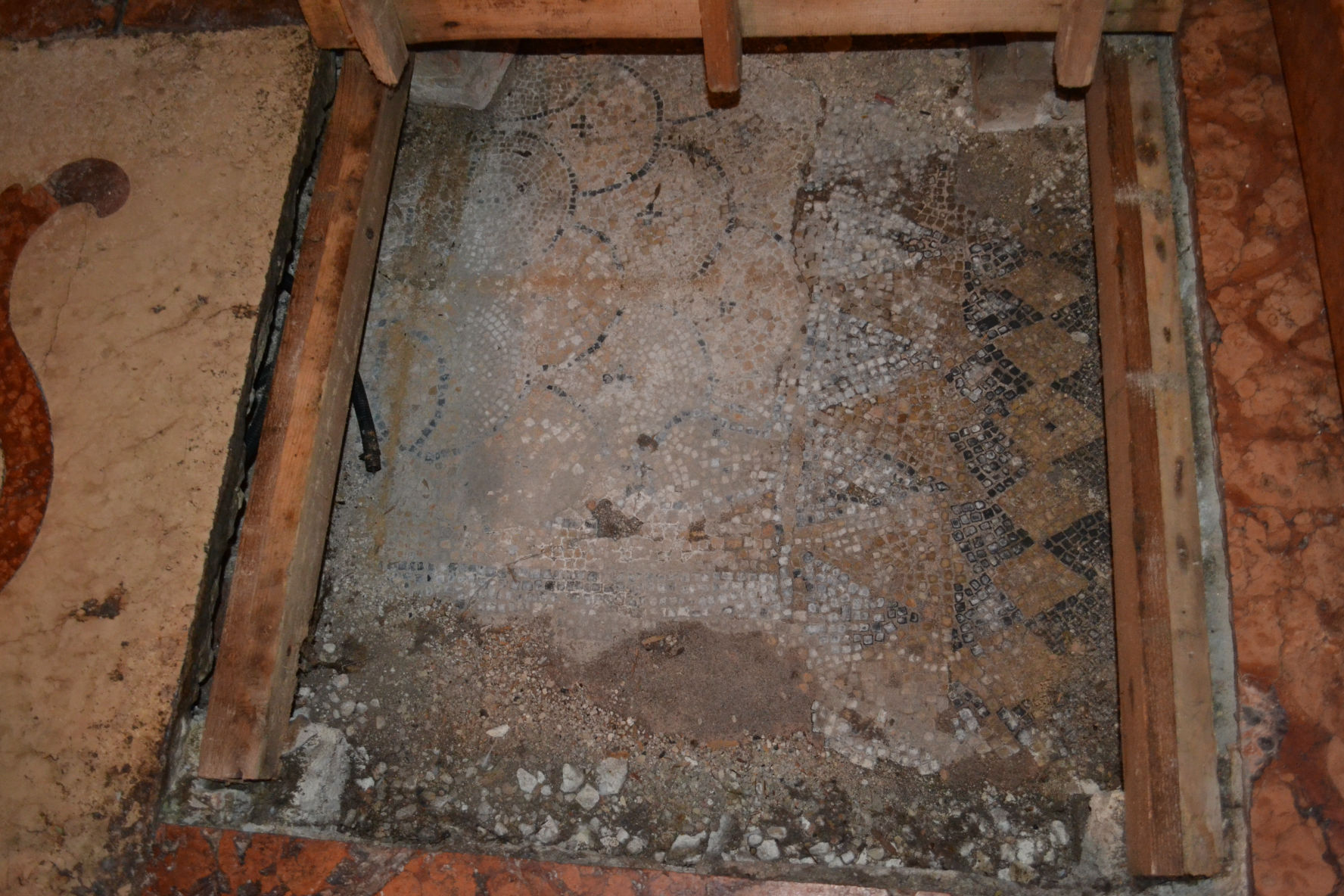
In fondo a destra della nobile Piazza dei Signori, nell'angolo più lontano da Piazza delle Erbe, si trova la millenaria ed austera chiesa di Santa Maria Antica. Venne edificata durante la prima metà dell'VIII secolo come luogo di culto annesso ad un importante monastero femminile. La chiesa di Santa Maria Antica è indissolubilmente legata alla storia della famiglia della Scala che ne fece la propria cappella privata, inglobandola nei palazzi della propria corte, e successivamente il proprio cimitero, costruendo nel muro e nel cortile della piccola chiesetta i mausolei dei propri membri più illustri: le Arche Scaligere.
Santa Maria Antica nasce come chiesa Longobarda nell'VIII secolo, e in seguito le verrà annesso un convento dotato di orti, vigne e frutteti che denunciano l'assetto rurale del centro di Verona nei secoli successivi alla caduta dell'Impero Romano. Con la rinascita che segue all'anno mille, Santa Maria Antica perde il terreno circostante a favore dei palazzi pubblici che velocemente le sorgono attorno.
E’ stata irrimediabilmente danneggiata durante il terremoto, che nel 1117 devastò Verona, compresa parte dell'Arena, che perse quasi completamente il secondo anello. Le enormi pietre dell'Arena crollata furono recuperate dai cittadini per le costruzioni e anche Santa Maria Antica, ha visibili in sacrestia alcune di queste enormi pietre romane. Della prima chiesa rimane solo un frammento di pavimento a mosaico, con tessere bianche e nere, nella parte sinistra dell’altare.
At the bottom on the right of the noble Piazza dei Signori, in the corner farthest from Piazza delle Erbe, rises the millenary and austere church of Santa Maria Antica.
It was built during the first half of the 8th century as a place of worship included to an important female monastery. The church of Santa Maria Antica is inextricably linked to the history of the Della Scala family who made it its own private chapel, incorporating it in the palaces of its own court, and subsequently its own cemetery, building into the wall and in the courtyard of the small church the mausoleums of their most illustrious members: the Arche Scaligere.
Santa Maria Antica was born as a Longobard church in the 8th century, and later a convent with vegetable gardens and vineyards was annexed to it, proving the ruralization of the center of Verona in the centuries following the fall of the Roman Empire.
With the rebirth that follows the year 1000, Santa Maria Antica loses the surrounding land in favor of public buildings that quickly rise around it. It was irreparably damaged during the earthquake, which devastated Verona in 1117. Only a fragment remains of mosaic floor of the first church, with white and black tiles, on the left side of the altar.

Santa Maria Antica fu ricostruita con forme romaniche e riconsacrata nel 1185 dal Patriarca d'Aquileia. Nel corso dei secoli fu oggetto di numerosi interventi che ne modificarono profondamente l'aspetto originario. Nel duecento gli Scaligeri, i potenti signori di Verona che qui accanto avevano posto i loro palazzi del potere, la scelsero come propria cappella privata e nel seicento i suoi interni vennero adeguati al barocco gusto di quel tempo. Un nuovo restauro, eseguito negli ultimi anni dell'ottocento, ha restituito alla chiesa lo stile originario e quel profumo d'antico che ancora oggi seduce veronesi e turisti. Esternamente le chiesa, realizzata con fasce alternate di mattone e pietra, è ornata con piccoli finestrini a strombatura e soffocata dagli edifici circostanti che nascondono quasi totalmente le sue delicate forme. Pregevole il piccolo campanile quadrato, che trova la sua base sopra l'abside maggiore; è totalmente in tufo e in puro stile romanico, con finestre bifore nella cella campanaria e copertura a pigna conica in laterizio. Due sono le porte di accesso alla chiesa, una nella navata centrale e più importante è l'accesso al tempio attraverso l'ingresso laterale, sovrastato dal magnifico Sarcofago di Cangrande della Scala, uno dei maggiori monumenti della scultura veronese del trecento che si insinua nella parete della chiesa formando un’insieme di straordinaria e delicata bellezza.
Santa Maria Antica was rebuilt with Romanesque forms and re-consecrated in 1185 by the patriarch of Aquileia.
Over the centuries it was the object of numerous interventions that profoundly changed its original appearance: in the 13th century the Scaligeri, the powerful lords of Verona who had placed their palaces of power nearby, chose it as their own private chapel and in the 17th century its interiors were adapted to the baroque taste of the time. A new restoration, carried out in the last years of the 19th century, has given back to the church the original style and that fragrance of ancient that still today seduces the inhabitants of Verona and tourists. Externally the church, built with alternating bands of brick and stone and adorned with small windows in splay, is suffocated by the surrounding buildings that almost completely hide its delicate forms. The small square bell tower is valuable, having its base above the major apse; it is totally in tuff and in pure Romanesque style, with double lancet windows in the belfry and a conical brick vertex. The temple is accessed through a side entrance, surmounted by the magnificent Sarcophagus of Cangrande della Scala, one of the major monuments of the Veronese sculpture of the 14th century that creeps into the wall of the church forming a set of extraordinary and delicate beauty.
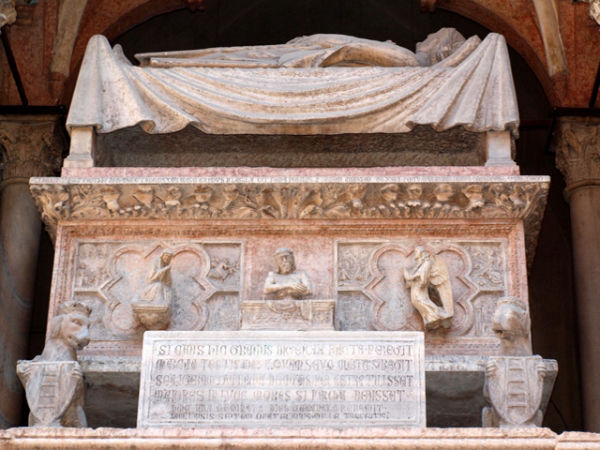
Il sarcofago è situato entro un arco trilobato e sovrastato da una statua equestre del principe, una fedele riproduzione dell'originale che è custodita nel museo di Castelvecchio, ritenuta la più bella statua equestre del XIV secolo, opera attribuita a Giovanni di Rigino. Cangrande è raffigurato sorridente e eretto sul cavallo appena arrestato dal galoppo vittorioso. Il vento fa ondeggiare la gualdrappa damascata che ricopre il cavallo sino agli zoccoli. Il capo di Cangrande è coperto con una maglia d'acciaio, mentre l'elmo a testa di cane alato è gettato dietro la schiena. Il braccio sembra porre la spada nel fodero, in segno di pace, mentre il sorriso dà un sentimento di benevolenza.
Il monumento viene così descritto da John Ruskin in The Stones of Venice:
«(...) un vigoroso baldacchino ad arco è sostenuto da due colonnine sporgenti, e in cima al tetto è la statua del cavaliere sul suo cavallo da battaglia; il suo elmo, munito d’ali di drago e coronato dalla testa di cane, gettato sulle spalle, e il largo drappo blasonato fluttuante all'indietro dal petto del cavallo è disegnato dall'antico ignoto artista con tale aderenza alla realtà che sembra ondeggiare nel vento, e la lancia pare agitata dal cavaliere e il suo cavallo di marmo sembra continuare ad accelerare il passo per lanciarsi in una carica più rapida e impetuosa, mentre le nuvole, argentee corrono dietro ad esso nel cielo.»
(John Ruskin)
The sarcophagus is located within a trilobate arch and surmounted by an equestrian statue of the Prince, a faithful reproduction of the original which is exhibited in the Museum of Castelvecchio, considered the most beautiful equestrian statue of the 14th century, attributed to Giovanni di Rigino. Cangrande is depicted smiling, erect on the back of the horse just arrested by the victorious gallop. Wind sways the damask caparison that covers the horse up to the hooves. Cangrande's head is covered with a steel mesh, while the winged dog helmet is rested behind his back. The arm seems to place the sword in its sheath, as a sign of peace, while the smile gives a feeling of benevolence.
The monument is so described by John Ruskin in The Stones of Venice:
"(...) a bold arched canopy is sustained by two projecting shafts. and on the pinnacle of its roof is the statue of the knight on his war-horse; his helmet, dragon-winged and crested with the dog’s head, tossed back behind his shoulders, and the broad and blazoned drapery floating back from his horse’s breast,-so truly drawn by the old workman from the life, that it seems to wave in the wind, and the knight’s spear to shake, and his marble horse to be evermore quickening its pace, and starting into heavier and hastier charge, as the silver clouds float past behind it in the sky."
(John Ruskin)
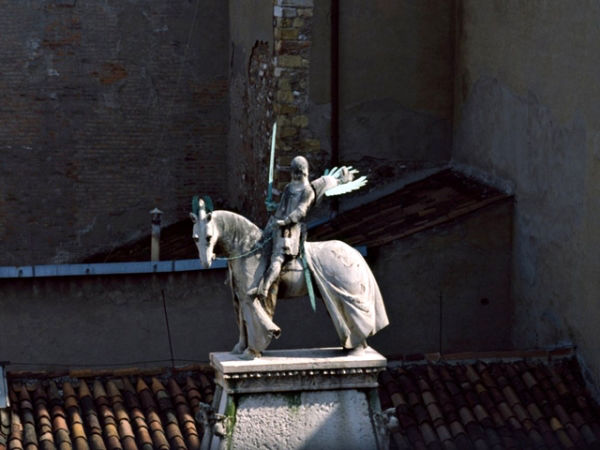
L'interno della chiesa è austero, ripartito su tre navate divise da due serie di sette colonne in pietra rossa con capitelli squadrati e archi a sesto rialzato, che terminano in altrettante piccole absidi ricavate nello spessore del muro. Le absidi laterali sono decorate con fasce alternate di mattoni rossi e tufo, mentre nell'abside centrale rimangono alcuni pregevoli frammenti di affreschi trecenteschi. Pur scevre di particolari opere d'arte, le nude pareti conservano due interessanti lapidi marmoree: accanto alla porta che conduce alla sacrestia una lapide del XII secolo ricorda la consacrazione della chiesa ad opera del patriarca Gotifredo (A. MCLXXXV indicit. Die sabati IX intrante novemb dom. Ptriarca Gotifredus quile-iensis dedicavit ecclesiam - Sanct Marie Antique). Sulla parete di sinistra si trova una lapide quattrocentesca che elenca le incredibili reliquie che sarebbero conservate nell'altare maggiore e celebra la consacrazione dello stesso ad opera di papa Alessandro III.
The interior of the church is austere, with three naves separated by two series of seven columns in red stone with square capitals and raised arches, ending in as many small apses carved in the thickness of the wall. The side apses are decorated with alternating bands of red bricks and tuff, while in the central apse there are some valuable fragments of 14th century frescoes. Despite the lack of particular works of art, the bare walls retain two interesting marble tombstones: next to the door leading to the sacristy a plaque from the 12th century recalls the consecration of the church by the Patriarch Gotifredo (A. MCLXXXV indicit. Die sabati IX intrante novemb dom Ptriarca Gotifredus quile-iensis dedicavit ecclesiam - Sanct Marie Antique). On the left wall there is a 15th century plaque listing the incredible relics that would be kept in the main altar and celebrating the alleged consecration of the same by Pope Alexander III.
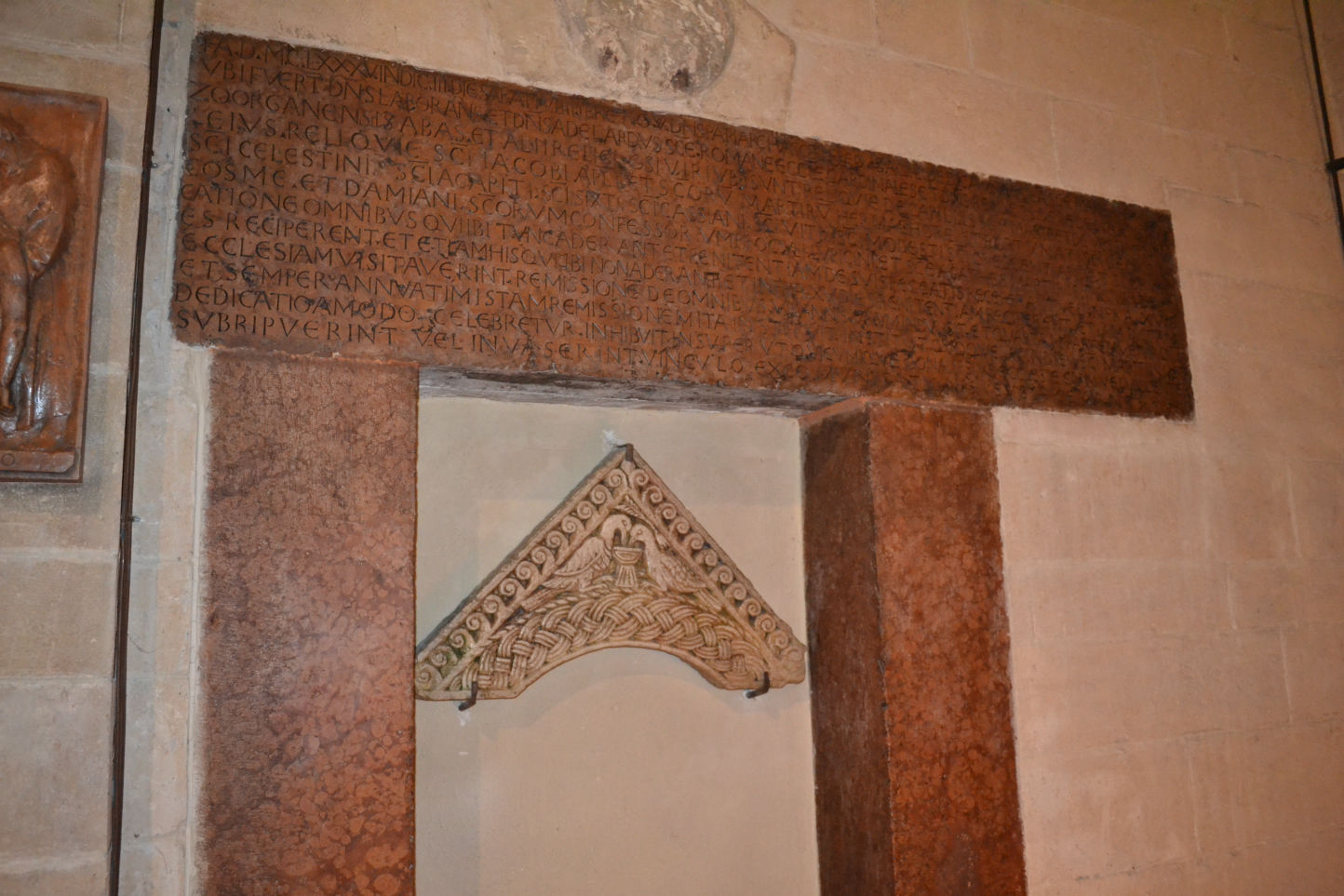
“A.MCLXXXV INDICT. III DIE SABATI IX INTRANTE NOVEMB. DOM. PTRIARCA GOTlFREDUS QUILE-IENSIS DEDICAVIT ECCLESIAM - SANCTE MARIE ANTIQUE - UBI FUERUNT D. LABORANS D. ADELARDUS S.R.E. CARDINALIS ET D. PEPO EPISCOPUS DE PEDENA ET OBIZO ORGANENSIS ABBAS ET ALlI RELIGIOSI VIRI UBI SUNT RELIQUIE DE CAUILLIS SANCTE MARIE ET DE VESTIMENTIS EIUS RELIQUIE S. IACOBI APOSTOLI ET SS. MARTIRUM HERMACHORE ET FORTUNAI SS. GEORGlI ET CELESTINI SIXTI CASSIANI - VITI MODESTI CRESCENTIANI COSMI DAMIANI ET PROCULl- LUPICINI CONFESS. ET S. AGATE MARTYRIS IN QUA DEDICATIONE OMNIBUS QUI IBI TUNC ADERANT ET INFRA XV DIES POENITENTIAM RECEPE
“L’anno 1185, indizione III, sabato 9 all’inizio di novembre, Gotifredo patriarca di Aquileia dedicò la Chiesa di Santa Maria Antica, dove intervennero Lavorente e Adelardo cardinali di S.R.C. Pepone vescovo di Pedena e Obizo abate di Santa Maria in Organo e altri religiosi. Qui si trovano le reliquie dei capelli di Santa Maria e delle sue vesti. Le reliquie di S. Giacomo apostolo e dei santi martiri Ermagora e Fortunato, di san Giorgio e san Celestino, san Sisto, san Cassiano, san Vito, san Modesto, san Crescenziano e dei santi Cosma e Damiano, dei santi confessori Procolo e Lupicino e di Santa Agnese martire. In questa consacrazione (Gotifredo) concesse a tutti coloro che erano presenti e che avessero ricevuto la penitenza dei loro peccati o l’avessero ricevuta entro 15 giorni, anche a coloro che erano assenti e avessero ricevuta la penitenza entro 15 giorni e avessero anche visitato la chiesa, senza eccezione, il perdono per tutti i peccati di 7 anni e la quarta parte dei veniali sempre ogni anno, (concesse) questa remissione. Così stabilì pure che d’ora in poi questa dedicazione fosse celebrata nel giorno di San Martino. Stabilì inoltre che tutti coloro i quali avessero sottratto di nascosto oppure con la violenza avessero occupato le proprietà della medesima chiesa fossero colpiti da scomunica.”
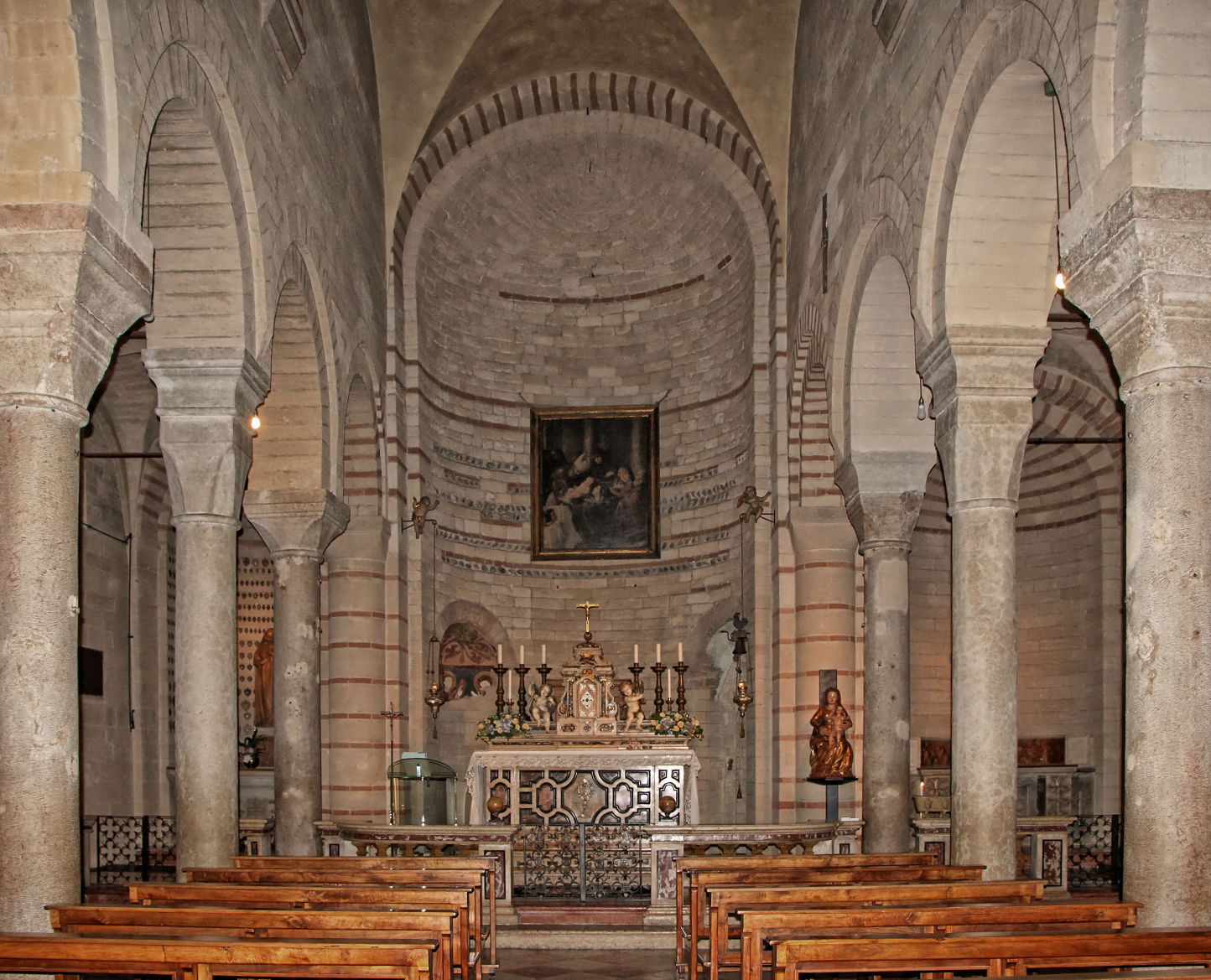
Caratteristice le colonne della navata centrale che, secondo la tradizione Templare, devono essere state recuperate da altre chiese distrutte e riutilizzate. Curiose perché sono accoppiate nel senso della larghezza della chiesa e così si trovano cinque coppie di colonne, uguali a due a due ma differenti dalle altre coppie.
I quadri e le statue che addobbano l’interno della chiesa, il grande Crocifisso, e le altre pregevoli raffigurazioni, non pesano assolutamente sullo stile scevro e severo, ma carico di grande energia della Chiesa Romanica
Santa Maria Antica è una piccola chiesa dall'atmosfera mistica e raccolta che assieme alle Arche Scaligere che le sorgono attorno permette di immergersi completamente nella Verona medievale.
Ulteriori immagini e particolari possono essere ammirati nella sezione Galleria del sito
A breve sarà disponibile un libro sulla storia di Santa Maria Antica, acquistabile direttamente in chiesa o su ordinazione.
The columns of the central nave are characteristic and, according to the Templar Order tradition, they must have been recovered from other churches destroyed and reused because they were full of energy from the previous use. Peculiar because they are coupled in the sense of the width of the church and so there are four pairs of columns, equal two by two but different from the other pairs.
The paintings and statues that adorn the interior of the church, the great Crucifix, and the other valuable depictions, do not weigh absolutely on the free and severe style, but full of great energy, of the Romanesque Church.
Santa Maria Antica is a small church with a mystical and intimate atmosphere that together with the Scaliger Tombs (Arche Scaligere) that rise around it allows you to immerse yourself completely in medieval Verona.
Additional images and details can be seen in the Gallery section of the site